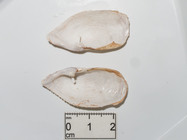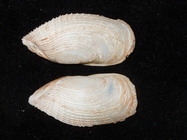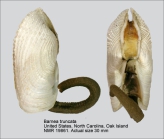MolluscaBase taxon details
Barnea truncata (Say, 1822)
156750 (urn:lsid:marinespecies.org:taxname:156750)
accepted
Species
Barnea (Anchomasa) truncata (Say, 1822) · alternative representation
Pholas truncata Say, 1822 · unaccepted (original combination)
marine
(of Pholas truncata Say, 1822) Say, T. (1822). An account of some of the marine shells of the United States. <em>Journal of the Academy of Natural Sciences, Philadelphia.</em> 2(1): 221-248; 2(2): 257-276, 302-325., available online at http://biodiversitylibrary.org/page/36831411
page(s): 321 [details]
page(s): 321 [details]
Distribution geographic range not obtained; has been recorded in the Bay of Fundy
Distribution geographic range not obtained; has been recorded in the Bay of Fundy [details]
MolluscaBase eds. (2024). MolluscaBase. Barnea truncata (Say, 1822). Accessed at: https://www.molluscabase.org/aphia.php?p=taxdetails&id=156750 on 2024-04-19
![]() The webpage text is licensed under a Creative Commons Attribution 4.0 License
The webpage text is licensed under a Creative Commons Attribution 4.0 License
original description
(of Pholas truncata Say, 1822) Say, T. (1822). An account of some of the marine shells of the United States. <em>Journal of the Academy of Natural Sciences, Philadelphia.</em> 2(1): 221-248; 2(2): 257-276, 302-325., available online at http://biodiversitylibrary.org/page/36831411
page(s): 321 [details]
basis of record Bousfield, E.L. 1960. Canadian Atlantic sea shells. National Museum of Canada, Ottawa. 72 p. [details]
additional source Gofas, S., Afonso, J.P. & Brandào, M. (1985). Conchas e Moluscos de Angola = Coquillages et Mollusques d'Angola. [Shells and molluscs of Angola]. Universidade Agostinho / Elf Aquitaine Angola: Angola. 140 pp. Printed without date. (look up in IMIS) [details]
additional source Ardovini, R.; Cossignani, T. (2004). West African seashells (including Azores, Madeira and Canary Is.) = Conchiglie dell'Africa Occidentale (incluse Azzorre, Madeira e Canarie). English-Italian edition. L'Informatore Piceno: Ancona, Italy. ISBN 88-86070-11-X. 319 pp. (look up in IMIS) [details]
additional source Barnard, K. H. (1964). Contributions to the knowledge of South African marine mollusca. Part V. Lamellibranchiata. <em>Annals of the South African Museum.</em> 47(3): 361-593., available online at http://biodiversitylibrary.org/page/40854756
page(s): 565. [details]
additional source Kilburn, R.N. & Rippey, E. (1982) Sea Shells of Southern Africa. Macmillan South Africa, Johannesburg, xi + 249 pp.
page(s): 203. [details]
additional source Turgeon, D. D., W. G. Lyons, P. Mikkelsen, G. Rosenberg, and F. Moretzsohn. 2009. Bivalvia (Mollusca) of the Gulf of Mexico, Pp. 711–744 in Felder, D.L. and D.K. Camp (eds.), Gulf of Mexico–Origins, Waters, and Biota. Biodiversity. Texas A&M Press, Colleg [details] Available for editors [request]
[request]
additional source Huber, M. (2010). <i>Compendium of bivalves. A full-color guide to 3,300 of the world's marine bivalves. A status on Bivalvia after 250 years of research</i>. Hackenheim: ConchBooks. 901 pp., 1 CD-ROM. (look up in IMIS) [details]
additional source Velásquez M., Valentich-Scott P. & Capelo J.C. (2017). Marine boring bivalve mollusks from Isla Margarita, Venezuela. <em>The Festivus.</em> 49(3): 247-269. [details]
additional source Alexander, R. C. (1952). <i>Barnea truncata</i> (Say) at South Cape May, New Jersey. <em>The Nautilus.</em> 65(3): 73-74., available online at https://www.biodiversitylibrary.org/page/8524874 [details]
identification resource Cosel, R. von; Gofas, S. (2019). <i>Marine bivalves of tropical West Africa: from Rio de Oro to southern Angola</i>. Publications Scientifiques du Muséum, Paris, IRD Éditions, Marseille (Faune et Flore tropicales, volume 48): 1-1104.
page(s): 982-983 [details]
page(s): 321 [details]
basis of record Bousfield, E.L. 1960. Canadian Atlantic sea shells. National Museum of Canada, Ottawa. 72 p. [details]
additional source Gofas, S., Afonso, J.P. & Brandào, M. (1985). Conchas e Moluscos de Angola = Coquillages et Mollusques d'Angola. [Shells and molluscs of Angola]. Universidade Agostinho / Elf Aquitaine Angola: Angola. 140 pp. Printed without date. (look up in IMIS) [details]
additional source Ardovini, R.; Cossignani, T. (2004). West African seashells (including Azores, Madeira and Canary Is.) = Conchiglie dell'Africa Occidentale (incluse Azzorre, Madeira e Canarie). English-Italian edition. L'Informatore Piceno: Ancona, Italy. ISBN 88-86070-11-X. 319 pp. (look up in IMIS) [details]
additional source Barnard, K. H. (1964). Contributions to the knowledge of South African marine mollusca. Part V. Lamellibranchiata. <em>Annals of the South African Museum.</em> 47(3): 361-593., available online at http://biodiversitylibrary.org/page/40854756
page(s): 565. [details]
additional source Kilburn, R.N. & Rippey, E. (1982) Sea Shells of Southern Africa. Macmillan South Africa, Johannesburg, xi + 249 pp.
page(s): 203. [details]
additional source Turgeon, D. D., W. G. Lyons, P. Mikkelsen, G. Rosenberg, and F. Moretzsohn. 2009. Bivalvia (Mollusca) of the Gulf of Mexico, Pp. 711–744 in Felder, D.L. and D.K. Camp (eds.), Gulf of Mexico–Origins, Waters, and Biota. Biodiversity. Texas A&M Press, Colleg [details] Available for editors
additional source Huber, M. (2010). <i>Compendium of bivalves. A full-color guide to 3,300 of the world's marine bivalves. A status on Bivalvia after 250 years of research</i>. Hackenheim: ConchBooks. 901 pp., 1 CD-ROM. (look up in IMIS) [details]
additional source Velásquez M., Valentich-Scott P. & Capelo J.C. (2017). Marine boring bivalve mollusks from Isla Margarita, Venezuela. <em>The Festivus.</em> 49(3): 247-269. [details]
additional source Alexander, R. C. (1952). <i>Barnea truncata</i> (Say) at South Cape May, New Jersey. <em>The Nautilus.</em> 65(3): 73-74., available online at https://www.biodiversitylibrary.org/page/8524874 [details]
identification resource Cosel, R. von; Gofas, S. (2019). <i>Marine bivalves of tropical West Africa: from Rio de Oro to southern Angola</i>. Publications Scientifiques du Muséum, Paris, IRD Éditions, Marseille (Faune et Flore tropicales, volume 48): 1-1104.
page(s): 982-983 [details]
 Present
Present  Inaccurate
Inaccurate  Introduced: alien
Introduced: alien  Containing type locality
Containing type locality
From other sources
Distribution geographic range not obtained; has been recorded in the Bay of Fundy [details]Reproduction separate sexes, usually not dimorphic in shell structure; fertilization occurs within the mantle cavity anf young hatch as pelagic larvae (generalized for group) [details]
| Language | Name | |
|---|---|---|
| English | Atlantic mud-piddock | [details] |
To Biodiversity Heritage Library (100 publications) (from synonym Pholas truncata Say, 1822)
To Biodiversity Heritage Library (39 publications)
To European Nucleotide Archive (ENA)
To GenBank (2 nucleotides; 0 proteins)
To GenBank (2 nucleotides; 0 proteins) (from synonym Pholas truncata Say, 1822)
To USNM Invertebrate Zoology Mollusca Collection
To Yale Peabody Museum of Natural History (YPM IZ 079767)
To ITIS
To Biodiversity Heritage Library (39 publications)
To European Nucleotide Archive (ENA)
To GenBank (2 nucleotides; 0 proteins)
To GenBank (2 nucleotides; 0 proteins) (from synonym Pholas truncata Say, 1822)
To USNM Invertebrate Zoology Mollusca Collection
To Yale Peabody Museum of Natural History (YPM IZ 079767)
To ITIS
Website and databases developed and hosted by Flanders Marine Institute · Page generated on 2024-04-19 22:40:14+02:00 · Contact: Data Management Team




